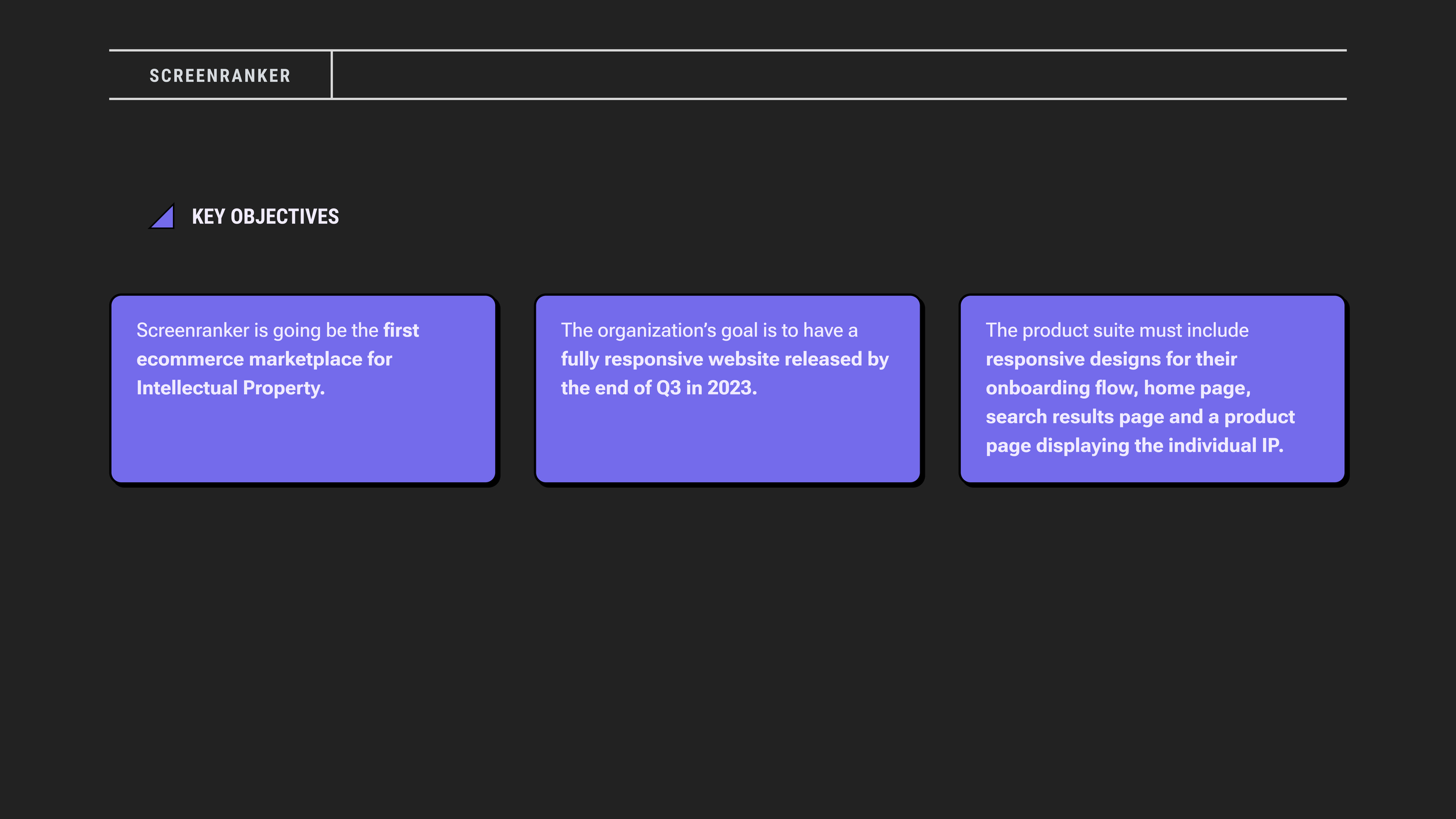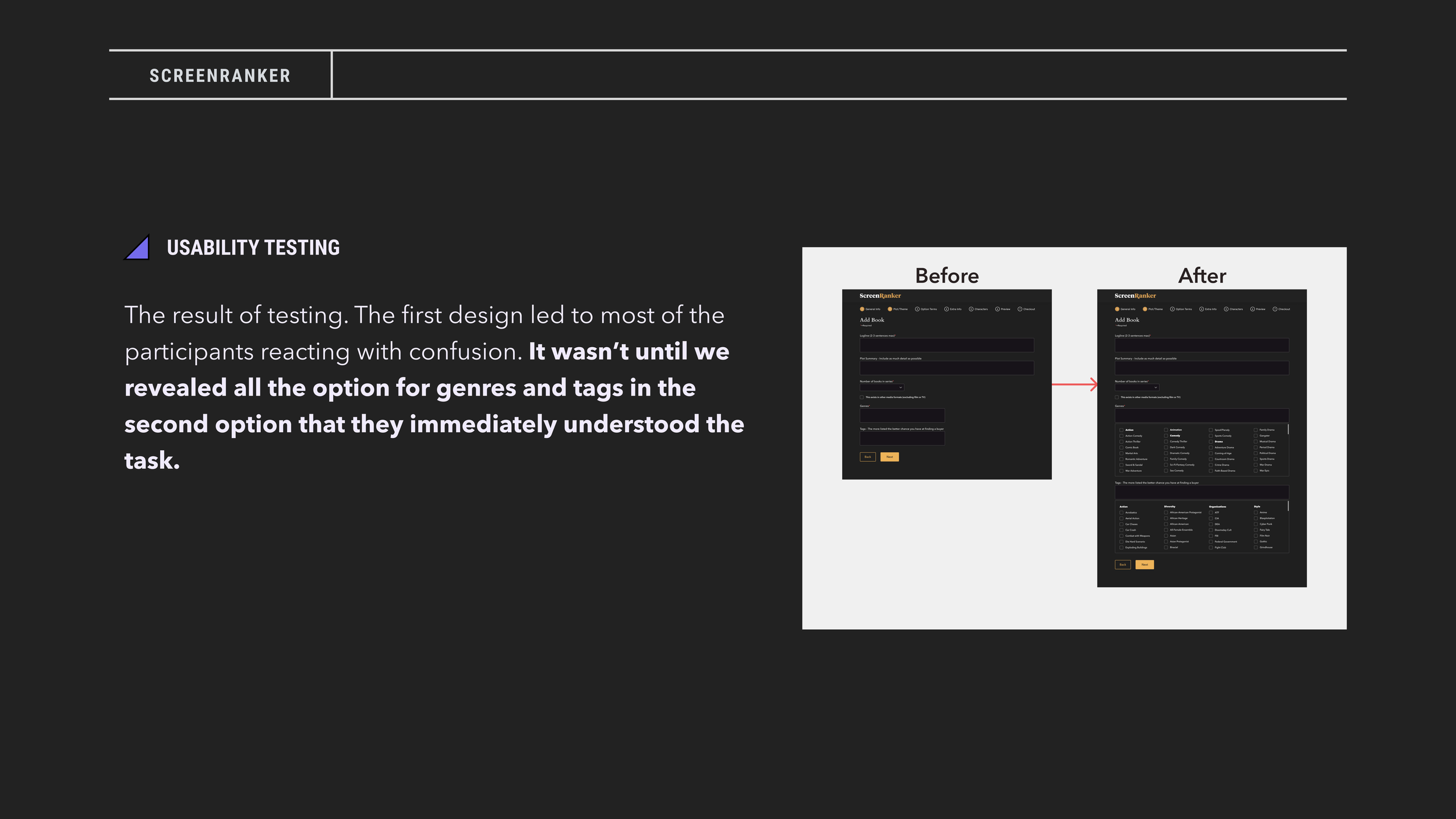Screenranker

















The Proposal
Screenranker is an e-commerce platform for creators to sell the screen rights to their intellectual property. Adapted IP is increasing in popularity, proven to be a better/safer ROI for producers, and there is yet to be a robust ecommerce solution that helps facilitate sale and search of this type of content. The founders are entertainment industry professionals who believe that this is the natural next step in content acquisition.
Key objective
Screenranker is going be the first ecommerce marketplace for Intellectual Property. This includes the sale of rights or ownership to any of the following: Books, Podcasts, Stage Plays, Documentaries, Video Games, Merchandise and Journalism.
The organization’s goal is to have a fully responsive website released by the end of Q4 in 2023.
The product suite must include responsive designs for their onboarding flow, home page, search results page and a product page displaying the individual IP.
Solution
Working with the founders and a technical team, I researched and designed a full e-commerce platform for acquiring intellectual property.
Design Process
Research & Synthesis
Architecture & UX Design
UI Design & Prototyping
Testing & Handoff
Research
The first step in our research was coming up with our goals.
Is buying/selling intellectual property a problem for for those trying to do it?
How does the process work for most people?
What works well and what does not work about the process of acquiring IP?
What information is needed for buyers to make the right decisions?
Market Research findings
The market for IP has recently undergone a radical shift. While in previous decades the buyers for IP were generally limited to the major studios that number has gone up dramatically with the proliferation of streaming services, production companies and smaller independent studios.
While more movies are not necessarily getting made, the amount of IP being purchased or optioned has increased dramatically.
Adapted IP is increasing in popularity, proven to be a better/safer ROI for producers, and there is yet to be a robust ecommerce solution that helps facilitate sale and search of this type of content.
The Blacklist, which is a website where screenwriters pay to post their original scripts online, has become enormously successful. This is despite the finding that most original scripts are a far less valuable commodity than known IP. Producers see IP as content with a built-in market while making a film based on an original film is far more of a gamble.
On the seller side, we found that creators ultimate goals are to have their work adapted. Very few books or other content make very much money but if their work can be adapted they are paid from that and given more exposure.
Competitive analysis
Key Takeaways
As of now there is no central location for selling intellectual property. Publisher’s Marketplace seems to be the most popular but advertising IP is mostly decentralized among social media and scattered marketplaces.
Most sites for advertising IP are medium specific and books are the only type of medium with any existing infrastructure. Meaning booksellers advertise in one place, other artists mostly tend to advertise their work through social media. While books have historically been the main source of stories for film and TV recently podcasts, video games and other types have launched successful franchises.
Existing marketing sites are not tailored to how people in the film industry search for IP to adapt. They do not have sophisticated search features that would allow for buyers to search for themes, or types of roles for actors to play. We found in our research with industry types that these are the most important factors in how they look for IP to adapt.
Primary Research
Surveys
We sent surveys to 1,200 people in the publishing industry, 1,000 people in the entertainment industry and 400 people involved in work in other mediums.
User Interviews
We recruited users from our email surveys for more in-depth discussions of the process of buying and selling IP. We spoke with seven people from the publishing industry and eight people from the entertainment industry. They were between the ages of 28 and 53.
“Literally anything can be IP. The Slap is now IP”
“They don’t always love to read, nor are they always interested in nuance”
“Knowing who to contact, getting interest, knowing what current trends are”
Personas
Using the information we gathered from our surveys and user interviews we created personas of our most likely buyers and sellers of IP. They are used exclusively using quotes from the interviews or surveys. The persona types were created based on matrices of profession and status. We were focused on recruiting “Hard users” so we wanted be able to identify the needs of high level creators and entertainment industry professionals but also mid-tier users as well.
We created personas for high and mid-tier producers, screenwriters and actors as well as best-selling authors and published authors who had not written a best seller.
A persona of a mid-tier screenwriter
Goals
Creator Goals
Show off their work to the right entertainment industry professional who will be able to get their work adapted.
Be able to field multiple offers to option their work.
Make money.
Industry Professional Goals
Be able to quickly search through quality material for something they will be passionate about making.
Quickly find work with specific story elements like “Female Lead”, ‘Horror/Sci-Fi” or “Mistaken Identity”.
Find material beyond books to adapt.
Business Goals
Become the leading marketplace for intellectual property.
Create first-class branding and UI to position ourselves as the best in class.
Quickly grow roster of creators to make the marketplace appealing to industry professionals.
Architecture
Based on the goals gleaned from our interviews and personas we began mapping out how the most important goals would be accomplished. The entertainment industry professionals did require a lot of information before making a decision. We wanted the process for creators (our paying customers) to be as simple as possible so we had to make some cuts from what was asked for.
Screenranker Site Map
User Flow for mid-tier screenwriter
Feature Set
Once we had the user and business goals in place and before we began designing we worked with our technical team to devise a feature set which would address all the goals we had in place on each page.
Wireframes
We created wireframes to help us test out different versions/iterations before moving on to the visual design.
Usability testing
We conducted three rounds of usability testing focusing on the onboarding process which is the most complex part of the site. The initial areas where users had difficulty getting through the flow was mainly on the Plot/Theme page with our design for picking multiple genres and tags to add to their work. In the first round only one participant out of five was able to easily complete the task while three had some diffficulty and one could not complete it. After some redesign and several more rounds of testing we had a session where four out of five participants were able to get through it easily and one completed it with some difficulty.
The results from our first round of testing
The result of testing. The first design led to most of the participants reacting with confusion. It wasn’t until we revealed all the option for genres and tags in the second option that they immediately understood the task.
UI Designs
UI Kit
The UI Kit for guiding the design system
Final UI Designs
Next Steps
Screenranker is due to launch in Q3 of 2023. Some of the next steps will be adding important features like a recommendation engine that was not deemed feasible for the time constraints.
On launch, the most important KPIs to track are:
Conversion rate through the onboarding process.
Customer retention.
The amount of users communicating with one another to purchase IP. Measured by number of messages initiating conversations between buyers and sellers.
Each KPI has analytics set up to track it. Iterations will be made based upon the findings.


